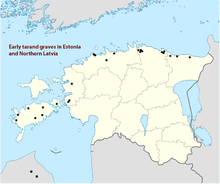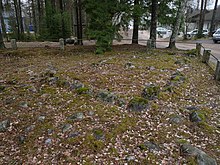Tarand tomb
Tarandgräber (estn. Tarandkalme , finn. Tarhakalmisto , Swed. Tarandgrav ) Steingräber are of bronze and iron age (about -500 -... 500 AD.) In Estonia , Latvia , Finland and in Scandinavia from surface (about 8 , 0 m × 3.0 m measured) rectangular Steineinhegungen exist, the Tarands be mentioned and similar Treuddar protrude from the surface and pebbles are covered.
description
According to age and construction, they are divided into: early, typical and late Tarand graves. Early forms were found in the coastal zone of northern and western Estonia, on the islands in southern Finland, in east-central Sweden, in northern Latvia and in Courland . About 500 burial grounds have been found in Estonia and Northern Latvia. They are fairly evenly distributed, with the exception of western Estonia. The Estonian Tarand tombs are particularly large, whereas the Finnish ones are small and have a more obscure construction. For a long time, the Swedish Tarand graves were difficult to find. Because of the C14 dating, it was possible to date them to the Bronze Age and the earliest Iron Age, a surprisingly early dating compared to the Finnish and Baltic tombs, but confirmed by a newly excavated group.
The prehistoric enclosure initially contained body graves as individual burials. As time went on, cremation became more common, and the artifacts were scattered around the Tarand area, but also outside the enclosure. Most of the artifacts were found in the central part of the Tarand or around the larger stones. Artifacts as well as bones were also scattered among the stones.
New archaeological investigations on Saaremaa have shown that the houses of the dead there are wooden structures that partly rest on stone foundations. Cult houses were also found. It is therefore possible that the Tarand tombs of the Iron Age (from 50 AD - 450 AD) were wooden structures on a stone foundation.
Uppland
The Swedish Tarand tomb complexes were found on burial grounds from the Late Bronze Age. The Tarand tombs from Täby in Uppland in Sweden , excavated in 1967, consist of a 18 m long and 3 m wide stone enclosure, which is divided into cells by rows of stones. It was located in the southern part of the large grave field and was oriented east-west. At the same time, a rectangular stone setting, which was divided into two cells, was examined. Two of the graves were dated 1500 BC. Dated. Two similar graves were investigated at Skälby and Smedby in Uppland. Unusual shards were found in some graves. The tombs are similar to the Tarand tombs in Estonia and Finland dating from 100 to 500 AD. The Tarand tombs at Täby demonstrate the existence of cultural links between the Baltic States, southwest Finland and east Uppland, a theory proposed by the Finn Carl Fredrik Meinander (1916-2004) and the Swede Björn Ambrosiani (born 1928) was discussed.
literature
- Björn Feldt: En ny gravtyp i en tid av förändrade samhällsstrukturer. In: Fornvännen , 98th year (2003), No. 1, pp. 13-25, ISSN 0015-7813 . ( online )
- Valter Lang: Kaks tarandkalmet Viimsis, Jõelähtme kihelkonnas. (= Töid arheoloogia alalt 2) Eesti Teaduste Akadeemia, Tallinn 1993, pp. 5-66, ISBN 9985500199 .
- Valter Lang: An early tarand-grave and clearance cairn at Tõugu, north Estonia . In: TATÜ, 43: 4 (1994), pp. 383-385.
- Marika Mägi: Mortuary houses in Iron age Estonia. In: Estonian Journal of Archeology 2005, No. 2, pp. 93-131, ISSN 1406-2933 .
- Mati Mandel: About the excavations of the Tarand tombs of Poanse . In: TATÜ, 27, 1, (1978), pp. 78-81.
- Monica Modin: Tarandgravar i Täby . In: Fornvännen , 68th year (1973), No. 2, pp. 65-70, ISSN 0015-7813 . ( online )
Individual evidence
- ↑ Estonian stone boxes , on the other hand, are usually set in round stones and deepened
- ↑ [1]
- ↑ Agneta Bennett: Nyupptäckta swedish tarandgravar In: Fornvännen 59-67 [2]

